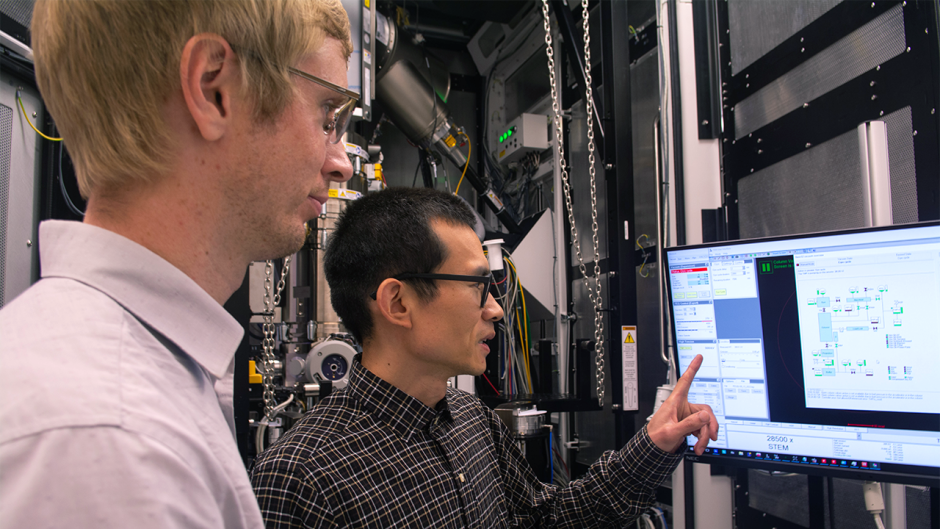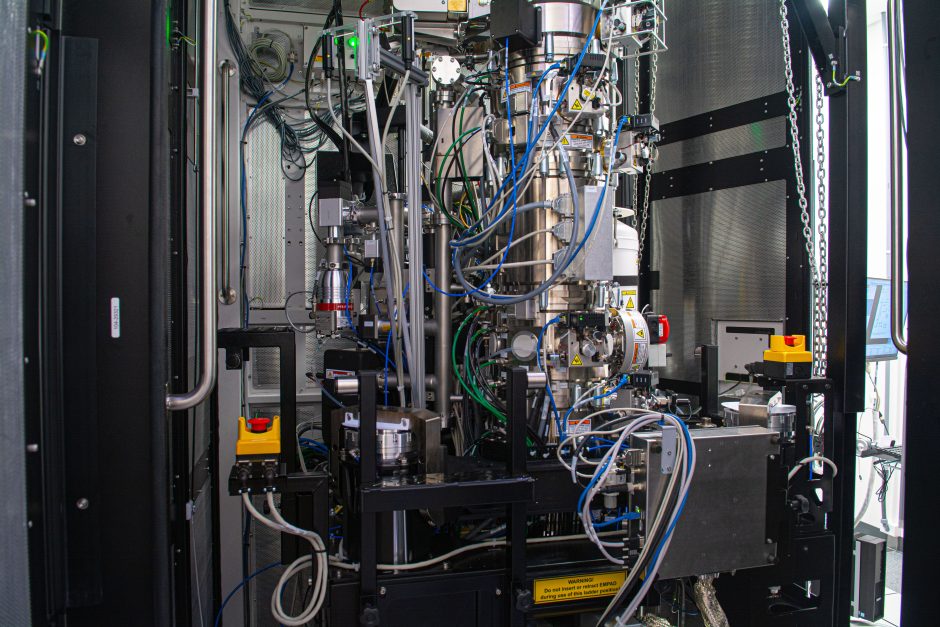In pursuit of better batteries

MU researchers Matthias J. Young (left) and Xiaoqing He are using a $500,000 grant from NSF to explore a key technical challenge preventing lithium-ion batteries from achieving optimal energy performance.
From personal electronics to electric vehicles, lithium-ion batteries are used in many technologies today. Over the last 30 years, scientists have worked to improve the overall safety and performance of these batteries by converting a key component, called electrolytes, from liquid to solid — partly due to an issue of the liquid being flammable.
Yet, while solid-state lithium-ion batteries — using solid electrolytes — are considered by many to be the next big advancement in battery technology, these batteries continue to suffer from performance issues. That’s why a team of researchers at the University of Missouri are working to figure out why this is happening. What the team discovers through their research could ultimately help advance the future of battery technology as scientists continue developing solutions for a safer lithium-ion battery that’s also better optimized for energy performance.
“We’re working to develop a fundamental understanding about why the performance is lacking with these solid-state lithium-ion batteries so that we can intelligently address it and make them work as well as they should,” said Matthias J. Young, an assistant professor with joint appointments in the Department of Biomedical, Biological and Chemical Engineering and the Department of Chemistry.

A Thermo Fisher Scientific Spectra 300 Transmission Electron Microscope (TEM) from the Electron Microscopy Core located in the Roy Blunt NextGen Precision Health building.
The team recently received a three-year, $500,000 grant from the National Science Foundation (NSF) to better understand the origin of this issue, which they believe may occur at a key connection point on the battery.
“We’re going to look at what’s forming at that interface, and then use that knowledge to understand how and why those reactions are taking place,” Young said.
To help the team determine their findings, they will use a specialized electron microscope — a Thermo Fisher Scientific Spectra 300 Transmission Electron Microscope (TEM) — from the Electron Microscopy Core (EMC) located in the Roy Blunt NextGen Precision Health building. The microscope is capable of seeing and identifying atoms, according to Xiaoqing He, a senior scientist in the EMC and adjunct assistant professor in the Department of Mechanical and Aerospace Engineering.
“This microscope is a powerful analytical tool that allows us to gather much more detailed information that’s otherwise not obtainable by other microscopy tools,” He said. “Here, we can use it to systematically study the interface between the lithium-ion battery cathode and the solid-state electrolyte to better understand the nature of the interface both chemically and structurally.”
Their work will also use thin film polymer coatings — an expertise of Young’s lab — to help the team probe and understand the chemical reactions taking place.
“These coatings act as selective membranes and will only let certain things move between the two materials,” Young said. “By controlling those reactions and observing what’s going on, we believe that insight can ultimately help us understand the fundamentals of what’s happening.”
The team will use the collective information in the pursuit of a potential solution.
“We will ultimately use this knowledge to be able to introduce an engineered interface that will prevent the undesired reactions from occurring and still maintain the desired energy properties — so the battery can charge and discharge quickly,” Young said.
Striving to make a difference
How they got where they are today may be different, but both He and Young share a common bond over an interest to solve technical challenges to benefit others.
As a young child growing up in rural China, He did not have many opportunities to see different types of advanced technologies. But watching his father work to repair and maintain their small two-wheel walking tractor left a lasting impression on him.
“My father did most of the repairs and maintenance himself,” He said. “That is a big deal considering he did not go to school at all. I clearly remembered he was struggling with reading the manuals and sometimes needed my help with understanding the manuals; although I was only in the first grade and could only help a little. My father’s persistent pursuit of new knowledge and not giving up easily despite all the obstacles and failures he was facing really had a huge impact on my schooling and inspired me to be a scientist who can come up with newer and better technologies to help many people like my father.”
Young has always been interested in solving big technical problems. Ever since he enrolled in graduate school, Young has been fascinated with battery technology, because he felt it could help make a difference for humanity.
“It’s kind of like a Rubik’s cube,” Young said. “There are lots of facets to the problem but holding that in my mind and trying to think through and figure out how to address it in a surgical way where I get to the heart of the problem is something that I really enjoy. Some people like chess, some people like sudoku, and for me solving these complex engineering and science questions is a lot of fun.”
“Understanding interphase layer formation at the cathode/solid-electrolyte junction,” was awarded by the National Science Foundation (2219060). The content is solely the responsibility of the authors and does not necessarily represent the official views of the funding agencies.
Young would also like to acknowledge the contributions of Nikhila Paranamana with the proposal they submitted to NSF to receive this grant. Paranamana, an MU graduate student, will continue her work with the current project.
Young’s joint appointments are in the MU College of Arts and Science and the MU College of Engineering.










